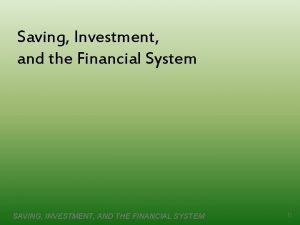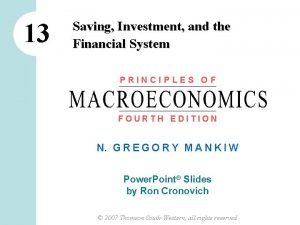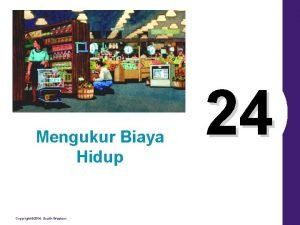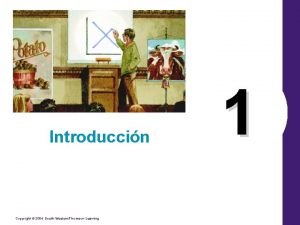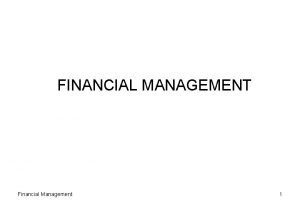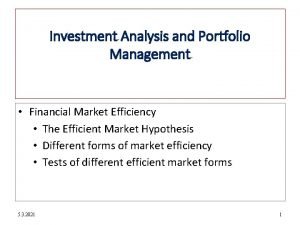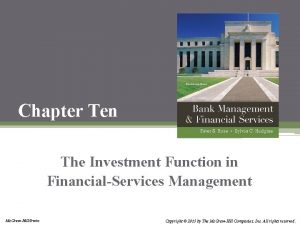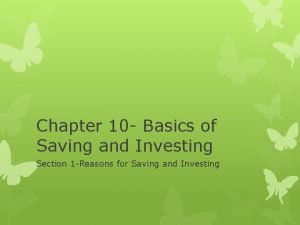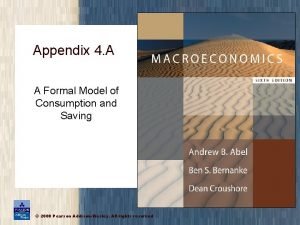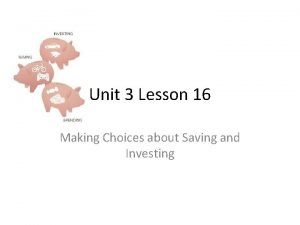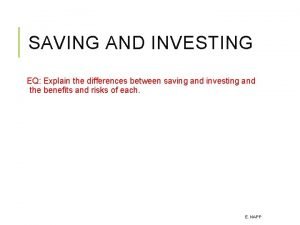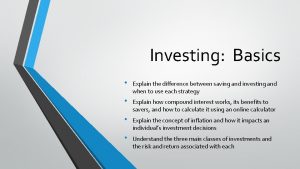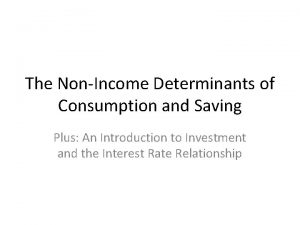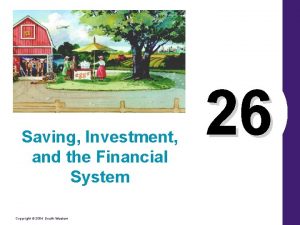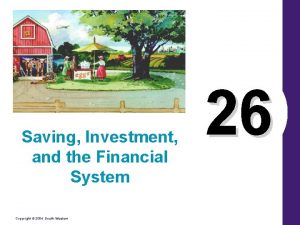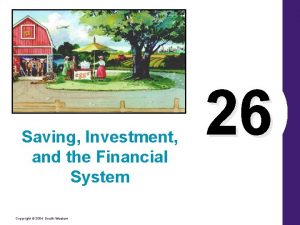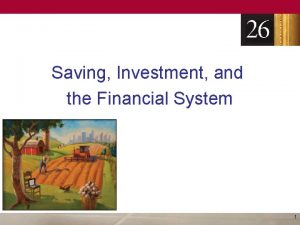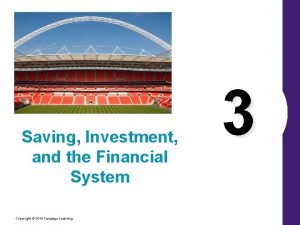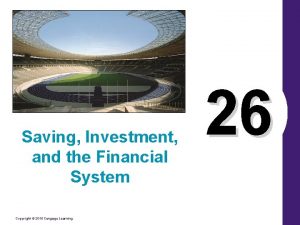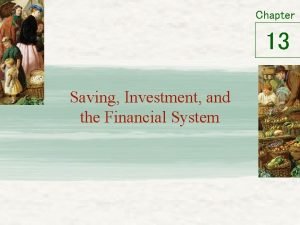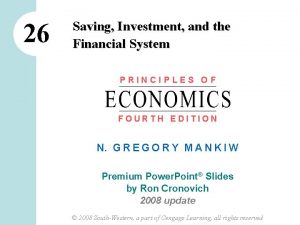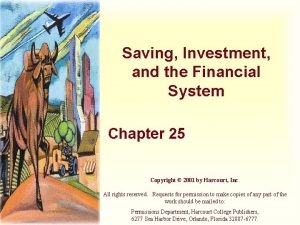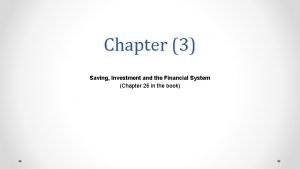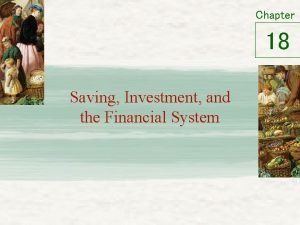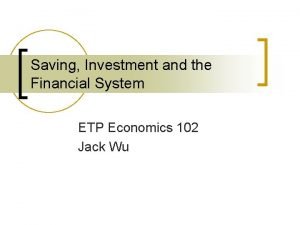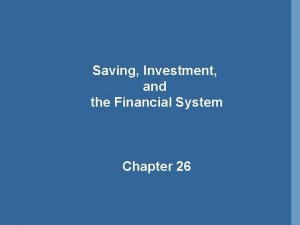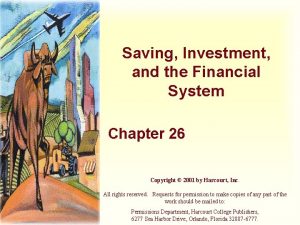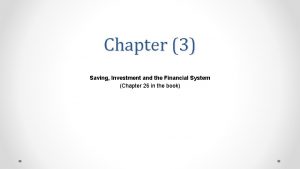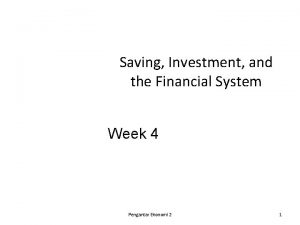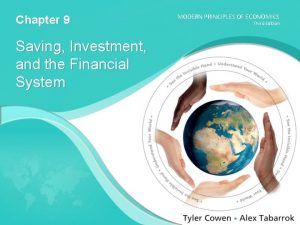Saving Investment and the Financial System Copyright 2004




















































- Slides: 52

Saving, Investment, and the Financial System Copyright © 2004 South-Western 26

2 Capital accumulation and finance • In Chapter 24 we saw the close link between the growth of real GDP and capital accumulation • Capital stock increases by saving and investing a part of the current output of the economy • The financial system is crucial to this process • Those who save in the economy are not necessarily those who invest • As a rule, households and firms spend less than they earn: in other words, they save • Firms spend more than they earn: i. e. they invest • Without a financial system, accumulation of capital and impovements in living standards would be very difficult in a market economy

The Financial System • The financial system consists of the group of institutions in the economy that help to match one person’s saving with another person’s investment. • It moves the economy’s scarce resources from savers to borrowers. Copyright © 2004 South-Western

FINANCIAL INSTITUTIONS IN THE U. S. ECONOMY • The financial system is made up of financial institutions that coordinate the actions of savers and borrowers. • . Copyright © 2004 South-Western

The financial system 5 • Altogether financial activities directly account for 4 to 5 % of GDP in developed market economies • The share of financial activities Turkey’s GDP in 2001 is 3. 7 % • The financial system consists of three parts – Financial markets – Financial intermediaries – Public bodies regulating financial institutions

Markets and intermediaries 6 • Financial markets are made of institutions through which savers can provide funds directly to borrowers – Bond market – Stock market • Financial intermediaries are those institutions through which savers can provide funds indirectly to borrowers – Banks – Mutual funds • Leasing and factoring companies are financial intermediaries • Brokerage houses (Menkul Değerler Şirketleri) are financial market institutions

7 Regulation of the financial system • Money is a very sensitive product, easy to abuse • Therefore, financial systems are everywhere very heavily regulated by governments • Those public bodies which supervise financial institutions are part of the financial system • We distinguish four institutions in Turkey: – The Central Bank (Türkiye Cumhuriyeti Merkez Bankası TCMB) – Treasury (Hazine) – Bank Regulation and Supervision Agency (Bankacılık Denetleme ve Düzenleme Kurulu BDDK) – Capital Markets Board (Sermaye Piyasası Kurulu SPK)

FINANCIAL INSTITUTIONS IN THE U. S. ECONOMY • Financial Markets • Stock Market • Bond Market • Financial Intermediaries • Banks • Mutual Funds Copyright © 2004 South-Western

FINANCIAL INSTITUTIONS IN THE U. S. ECONOMY • Financial markets are the institutions through which savers can directly provide funds to borrowers. • Financial intermediaries are financial institutions through which savers can indirectly provide funds to borrowers. Copyright © 2004 South-Western

Financial Markets • The Bond Market • A bond is a certificate of indebtedness that specifies obligations of the borrower to the holder of the bond. • Characteristics of a Bond • Term: The length of time until the bond matures. • Credit Risk: The probability that the borrower will fail to pay some of the interest or principal. • Tax Treatment: how income from bond is taxed Copyright © 2004 South-Western

• In developed economies, issuing bonds is a major source of finance for private corporations as well as central and local government • In Turkey the bond market is fully dominated by Treasury bonds (T-bills) and private company bonds are almost nonexistent Copyright © 2004 South-Western

Financial Markets • The Stock Market • Stock represents a claim to partial ownership in a firm and is therefore, a claim to the profits that the firm makes. • The sale of stock to raise money is called equity financing. • Compared to bonds, stocks offer both higher risk and potentially higher returns. • . Copyright © 2004 South-Western

• All major financial centers have stock exchanges: New York, London, Tokyo, Frankfurt, Paris, etc. • Istanbul Stock Exchange (İstanbul Menkul Değerler Borsası İMKB) is growing stock market Copyright © 2004 South-Western

Financial Markets • The Stock Market • Most newspaper stock tables provide the following information: • • Price (of a share) Volume (number of shares sold) Dividend (profits paid to stockholders) Price-earnings ratio Copyright © 2004 South-Western

Financial Intermediaries • Financial intermediaries are financial institutions through which savers can indirectly provide funds to borrowers. Copyright © 2004 South-Western

Financial Intermediaries • Banks • take deposits from people who want to save and use the deposits to make loans to people who want to borrow. • pay depositors interest on their deposits and charge borrowers slightly higher interest on their loans. Copyright © 2004 South-Western

Financial Intermediaries • Banks help create a medium of exchange by allowing people to write checks against their deposits. • A medium of exchanges is an item that people can easily use to engage in transactions. • This facilitates the purchases of goods and services. • Two state banks (Ziraat and Halk) and four private banks (Garanti, İş, Ak and Yapı Kredi) make up a large part of the banking system • Total deposits in the banking system is about 50 percent of GDP Copyright © 2004 South-Western

Financial Intermediaries • Mutual Funds • A mutual fund is an institution that sells shares to the public and uses the proceeds to buy a portfolio, of various types of stocks, bonds, or both. • They allow people with small amounts of money to easily diversify. Copyright © 2004 South-Western

Mutual funds 19 • In Turkey the equivalent of mutual funds is called investment funds (yatırım fonları) – A-type funds have at least 25 % of their portfolio in stocks – B-type funds have mainly bonds and REPOs – REPOs are short maturity transactions that involve purchase and repurchase of T-bills

SAVING AND INVESTMENT IN THE NATIONAL INCOME ACCOUNTS • Recall that GDP is both total income in an economy and total expenditure on the economy’s output of goods and services: Y = C + I + G + NX Copyright © 2004 South-Western

Some Important Identities • Assume a closed economy – one that does not engage in international trade: Y=C+I+G Copyright © 2004 South-Western

Some Important Identities • Now, subtract C and G from both sides of the equation: Y – C – G =I • The left side of the equation is the total income in the economy after paying for consumption and government purchases and is called national saving, or just saving (S). Copyright © 2004 South-Western

Some Important Identities • Substituting S for Y - C - G, the equation can be written as: S=I Copyright © 2004 South-Western

Some Important Identities • National saving, or saving, is equal to: S=I S=Y–C–G S = (Y – T – C) + (T – G) Copyright © 2004 South-Western

The Meaning of Saving and Investment • National Saving • National saving is the total income in the economy that remains after paying for consumption and government purchases. • Private Saving • Private saving is the amount of income that households have left after paying their taxes and paying for their consumption. Private saving = (Y – T – C) Copyright © 2004 South-Western

The Meaning of Saving and Investment • Public Saving • Public saving is the amount of tax revenue that the government has left after paying for its spending. Public saving = (T – G) Copyright © 2004 South-Western

The Meaning of Saving and Investment • Surplus and Deficit • If T > G, the government runs a budget surplus because it receives more money than it spends. • The surplus of T - G represents public saving. • If G > T, the government runs a budget deficit because it spends more money than it receives in tax revenue. Copyright © 2004 South-Western

The Meaning of Saving and Investment • For the economy as a whole, saving must be equal to investment. S=I Copyright © 2004 South-Western

THE MARKET FOR LOANABLE FUNDS • Financial markets coordinate the economy’s saving and investment in the market for loanable funds. Copyright © 2004 South-Western

THE MARKET FOR LOANABLE FUNDS • The market for loanable funds is the market in which those who want to save supply funds and those who want to borrow to invest demand funds. Copyright © 2004 South-Western

THE MARKET FOR LOANABLE FUNDS • Loanable funds refers to all income that people have chosen to save and lend out, rather than use for their own consumption. Copyright © 2004 South-Western

Supply and Demand for Loanable Funds • The supply of loanable funds comes from people who have extra income they want to save and lend out. • The demand for loanable funds comes from households and firms that wish to borrow to make investments. Copyright © 2004 South-Western

Supply and Demand for Loanable Funds • The interest rate is the price of the loan. • It represents the amount that borrowers pay for loans and the amount that lenders receive on their saving. • The interest rate in the market for loanable funds is the real interest rate. Copyright © 2004 South-Western

Supply and Demand for Loanable Funds • Financial markets work much like other markets in the economy. • The equilibrium of the supply and demand for loanable funds determines the real interest rate. Copyright © 2004 South-Western

Figure 1 The Market for Loanable Funds Interest Rate Supply 5% Demand 0 $1, 200 Loanable Funds (in billions of dollars) Copyright© 2004 South-Western

Supply and Demand for Loanable Funds • Government Policies That Affect Saving and Investment • Taxes and saving • Taxes and investment • Government budget deficits Copyright © 2004 South-Western

Policy 1: Saving Incentives • Taxes on interest income substantially reduce the future payoff from current saving and, as a result, reduce the incentive to save. Copyright © 2004 South-Western

Policy 1: Saving Incentives • A tax decrease increases the incentive for households to save at any given interest rate. • The supply of loanable funds curve shifts to the right. • The equilibrium interest rate decreases. • The quantity demanded for loanable funds increases. Copyright © 2004 South-Western

Figure 2 An Increase in the Supply of Loanable Funds Interest Rate Supply, S 1 S 2 1. Tax incentives for saving increase the supply of loanable funds. . . 5% 4% 2. . which reduces the equilibrium interest rate. . . Demand 0 $1, 200 $1, 600 Loanable Funds (in billions of dollars) 3. . and raises the equilibrium quantity of loanable funds. Copyright© 2004 South-Western

Policy 1: Saving Incentives • If a change in tax law encourages greater saving, the result will be lower interest rates and greater investment. Copyright © 2004 South-Western

Policy 2: Investment Incentives • An investment tax credit (yatırım vergi istisnası) increases the incentive to borrow. • Increases the demand for loanable funds. • Shifts the demand curve to the right. • Results in a higher interest rate and a greater quantity saved. Copyright © 2004 South-Western

Policy 2: Investment Incentives • If a change in tax laws encourages greater investment, the result will be higher interest rates and greater saving. Copyright © 2004 South-Western

Figure 3 An Increase in the Demand for Loanable Funds Interest Rate Supply 1. An investment tax credit increases the demand for loanable funds. . . 6% 5% 2. . which raises the equilibrium interest rate. . . 0 D 2 Demand, D 1 $1, 200 $1, 400 Loanable Funds (in billions of dollars) 3. . and raises the equilibrium quantity of loanable funds. Copyright© 2004 South-Western

Policy 3: Government Budget Deficits and Surpluses • When the government spends more than it receives in tax revenues, the short fall is called the budget deficit. • The accumulation of past budget deficits is called the government debt. Copyright © 2004 South-Western

Policy 3: Government Budget Deficits and Surpluses • Government borrowing to finance its budget deficit reduces the supply of loanable funds available to finance investment by households and firms. • This fall in investment is referred to as crowding out. • The deficit borrowing crowds out private borrowers who are trying to finance investments. Copyright © 2004 South-Western

Policy 3: Government Budget Deficits and Surpluses • A budget deficit decreases the supply of loanable funds. • Shifts the supply curve to the left. • Increases the equilibrium interest rate. • Reduces the equilibrium quantity of loanable funds. Copyright © 2004 South-Western

Figure 4: The Effect of a Government Budget Deficit Interest Rate S 2 Supply, S 1 1. A budget deficit decreases the supply of loanable funds. . . 6% 5% 2. . which raises the equilibrium interest rate. . . Demand 0 $800 $1, 200 Loanable Funds (in billions of dollars) 3. . and reduces the equilibrium quantity of loanable funds. Copyright© 2004 South-Western

Policy 3: Government Budget Deficits and Surpluses • When government reduces national saving by running a deficit, the interest rate rises and investment falls. Copyright © 2004 South-Western

Policy 3: Government Budget Deficits and Surpluses • A budget surplus increases the supply of loanable funds, reduces the interest rate, and stimulates investment. Copyright © 2004 South-Western

Turkey: the rise in public debt % 50

51 Conclusion • Growth of output and accumulation of capital requires saving from current output with the aim of increasing the capital stock in the economy • Financial system is the vital link between those who save and those who invest • Financial markets work like other markets in the economy • They coordinate borrowing and lending, helping to allocate the economy’s scarce resources efficiently • Turkey’s financial system includes financial institutions such as banks and mutual funds and financial markets such as the bond market and the stock market

52 Conclusion • National saving equals private saving plus public saving S=(Y–T–C)+(T–G)=I • Saving and investmend decisions are reflected into the market for loanable funds • Supply and demand for loanable funds determine the real interest rate • The budget deficit of the government represents negative public saving, reducing national saving and the supply of loanable funds • Budget deficit crowds out private investment thus reducing growth of GDP and the living standards in the long run
 Chapter 26 saving investment and the financial system
Chapter 26 saving investment and the financial system Saving
Saving Saving investment and the financial system
Saving investment and the financial system Copyright 2004
Copyright 2004 Copyright 2004
Copyright 2004 Copyright 2004
Copyright 2004 Konsep biaya hidup
Konsep biaya hidup Copyright 2004
Copyright 2004 2004
2004 Copyright 2004
Copyright 2004 Copyright 2004
Copyright 2004 Nesova ravnoteza
Nesova ravnoteza Copyright 2004
Copyright 2004 Copyright 2004
Copyright 2004 Copyright 2004
Copyright 2004 Fixed investment and inventory investment
Fixed investment and inventory investment Fundamentals of analyzing real estate investments
Fundamentals of analyzing real estate investments Modern financial theory
Modern financial theory Financial investment analysis
Financial investment analysis Gfgi
Gfgi The investment function in financial services management
The investment function in financial services management Non financial methods
Non financial methods Lesson twelve saving and investing
Lesson twelve saving and investing Labour saving kitchen equipment
Labour saving kitchen equipment Chapter 10 basics of saving and investing
Chapter 10 basics of saving and investing Holding a variety of investments to reduce risk
Holding a variety of investments to reduce risk The life-cycle model of consumption and saving
The life-cycle model of consumption and saving Unit 3 lesson 2 saving and investing
Unit 3 lesson 2 saving and investing Insulation and energy saving grade 7
Insulation and energy saving grade 7 Chapter 6 saving and investing
Chapter 6 saving and investing Similarities between saving and investing
Similarities between saving and investing Explain the difference between saving and investing
Explain the difference between saving and investing Determinants of consumption
Determinants of consumption Hát kết hợp bộ gõ cơ thể
Hát kết hợp bộ gõ cơ thể Frameset trong html5
Frameset trong html5 Bổ thể
Bổ thể Tỉ lệ cơ thể trẻ em
Tỉ lệ cơ thể trẻ em Gấu đi như thế nào
Gấu đi như thế nào Tư thế worm breton
Tư thế worm breton Chúa sống lại
Chúa sống lại Các môn thể thao bắt đầu bằng tiếng bóng
Các môn thể thao bắt đầu bằng tiếng bóng Thế nào là hệ số cao nhất
Thế nào là hệ số cao nhất Các châu lục và đại dương trên thế giới
Các châu lục và đại dương trên thế giới Công thức tính độ biến thiên đông lượng
Công thức tính độ biến thiên đông lượng Trời xanh đây là của chúng ta thể thơ
Trời xanh đây là của chúng ta thể thơ Mật thư tọa độ 5x5
Mật thư tọa độ 5x5 Làm thế nào để 102-1=99
Làm thế nào để 102-1=99 độ dài liên kết
độ dài liên kết Các châu lục và đại dương trên thế giới
Các châu lục và đại dương trên thế giới Thơ thất ngôn tứ tuyệt đường luật
Thơ thất ngôn tứ tuyệt đường luật Quá trình desamine hóa có thể tạo ra
Quá trình desamine hóa có thể tạo ra Một số thể thơ truyền thống
Một số thể thơ truyền thống Cái miệng nó xinh thế chỉ nói điều hay thôi
Cái miệng nó xinh thế chỉ nói điều hay thôi

